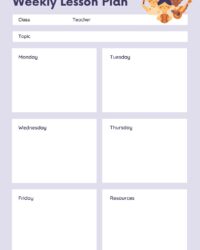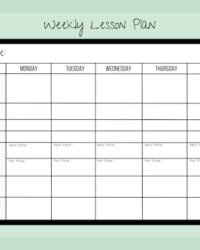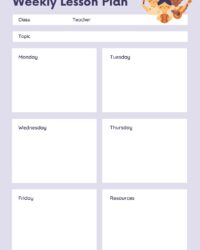Stepping into a kindergarten classroom, or even setting up learning activities at home, is an exciting adventure, isn’t it? But let’s be honest, behind all the glitter and glue sticks, there’s a lot of planning involved. Every day brings new opportunities for growth, discovery, and those wonderful “aha!” moments, and making sure those moments happen consistently requires a little bit of foresight. It can feel like a juggling act, trying to balance engaging activities with learning objectives, all while keeping the energy of little ones in mind.
That’s where a solid, well-organized plan comes in handy. It’s not about stifling creativity; it’s about providing a clear roadmap so you can focus more on the teaching and less on wondering what to do next. A structured approach ensures that you’re hitting all the important developmental milestones, from early literacy and numeracy to social-emotional skills, all wrapped up in fun, age-appropriate activities. Imagine having a simple tool that takes away some of that planning pressure, leaving you more time to genuinely connect with your young learners.
Why a Great Lesson Plan Makes All the Difference
Think about the whirlwind of a kindergarten day. One minute you’re singing an alphabet song, the next you’re mediating a dispute over a block tower, and then it’s time for storybook magic. Without a clear plan, it’s easy to feel overwhelmed or to miss out on covering important learning areas. A well-crafted lesson plan provides a framework that brings order to this delightful chaos. It helps you visualize the flow of your week, ensuring a balanced mix of active play, quiet time, structured lessons, and free exploration, all crucial for young minds to thrive.
Beyond just managing the classroom, a thoughtful lesson plan is an incredible time-saver. Instead of waking up each morning wondering what the day holds, you’ll have a clear guide. This not only reduces stress for you but also creates a more predictable and secure environment for the children. When they know what to expect, even generally, it fosters a sense of safety and allows them to engage more deeply in the learning process rather than spending energy trying to figure out the routine.
Furthermore, a good lesson plan ensures that learning is truly comprehensive. It allows you to intentionally weave in opportunities for cognitive development, physical activity, creative expression, and social interaction. You can map out how you’ll introduce new concepts, reinforce old ones, and observe individual progress. This holistic approach is fundamental in kindergarten, where every experience, from building with LEGOs to painting a masterpiece, is a chance for learning and growth.
Ultimately, a robust planning tool helps you be more intentional and less reactive. It empowers you to design experiences that are not only fun but also purposefully contribute to each child’s development. It transforms the abstract idea of “teaching” into a series of actionable, manageable steps, allowing you to focus on the truly important work: nurturing young learners.
Key Elements to Include in Your Kindergarten Lesson Plan
When you’re putting together your weekly plan, think about these vital components to ensure a well-rounded and effective learning experience:
- Clearly defined learning objectives for each activity or day.
- A list of all necessary materials and resources.
- Detailed descriptions of activities, including steps and variations.
- Methods for assessing understanding and progress, often through observation.
- Ideas for differentiation to meet diverse learning needs.
Overcoming Common Planning Hurdles
We all face challenges when it comes to planning. Maybe it’s finding enough time in a busy schedule, or perhaps it’s feeling uninspired and running out of fresh ideas. Sometimes, ensuring variety so that children don’t get bored or overly focused on one area can be tough. These hurdles are completely normal, and they’re exactly why having a structured template can be so beneficial.
A well-designed free weekly lesson plan template for kindergarten helps you bypass these common issues. It provides a pre-organized framework, prompting you to consider all the important aspects of a lesson without starting from scratch. This structure acts as a helpful reminder and a catalyst for creativity, giving you a strong foundation from which to build unique and exciting learning adventures for your little ones.
Getting Your Hands on a Practical Template
So, where does one find this magical tool that simplifies kindergarten planning? The good news is, there are plenty of helpful resources available, and many are completely free! A well-designed free weekly lesson plan template for kindergarten isn’t just a blank sheet of paper; it’s a thoughtful guide with sections for subjects, activities, materials, and even notes on individual children’s progress. It’s designed to be intuitive and adaptable, whether you’re a seasoned educator or a parent navigating homeschooling for the first time.
A practical template offers flexibility. You can print it out and handwrite your plans, or you can use it digitally, typing in your ideas and saving them for future reference. The beauty of these templates is that they encourage consistency in your planning while still allowing ample room for your unique teaching style and the specific needs of your children. They help you stay organized, making it easy to see your week at a glance and ensure that you’re covering all your bases.
Once you have your template, making it work for you is key. Don’t be afraid to customize it. Add sections that are specific to your daily routine, like snack time or outdoor play. Think about how you can integrate themes or special events. The goal is to make planning a seamless and even enjoyable part of your routine, freeing up your energy for the exciting, interactive moments with your kindergarteners. Here are some tips:
- Download and print or save the template to your device.
- Begin by mapping out the main learning areas for the week (e.g., literacy, math, arts).
- Fill in specific activities, keeping the children’s interests and developmental stages in mind.
- Note down any materials you’ll need to gather beforehand.
- Review your plan at the end of each week, making notes for future adjustments.
Having a clear, consistent plan really does transform the learning environment. It creates a sense of purpose for every activity and ensures that each day contributes meaningfully to a child’s growth. When you feel organized and prepared, that positive energy is contagious, making the classroom or home learning space a more joyful and effective place for everyone.
Embracing a structured planning tool can truly make your teaching journey smoother and more rewarding. It allows you to focus on what you do best: inspiring young minds and fostering a love for learning. Here’s to many wonderful, well-planned, and impactful weeks ahead with your eager kindergarteners!


